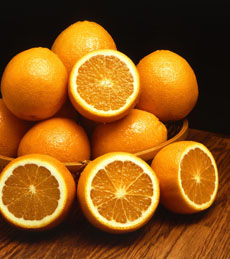TIP OF THE DAY: Uses For Orange Peel
|
As a follow up to yesterday’s tip on uses for food scraps, here are some tips to use orange peel after you’ve juiced or eaten the flesh. They are adapted from an original article by Katie Waldeck on Care2.com. CLEANING 1. Remove Water Stains. The oils in orange peels naturally remove stains on metal fixtures. Just rub the white side of peel on the fixtures to polish them up. 2. Polish Wood. The white side of the peel can also polish dull wood furniture. 3. Sponge. Still-moist orange peels are a natural sponge and leave a light citrusy scent. Try it on your stove top and counters. 4. Cleaning Solution. Toss some orange peels in a lidded jar and cover with white vinegar. Let it sit in the fridge for a few weeks and shake it occasionally. Transfer to a spray bottle, shake and use to clean surfaces, floors and windows. |
Juice the orange, use the peel. Photo by Scott Bauer | USDA Agricultural Research Service. |
|
 Enough peel for many uses! Photo courtesy FloridaJuice.com. |
AROUND THE HOUSE
5. Repel Insects. Ants, flies and mosquitoes don’t like limonene, a compound found in oranges and other citrus fruits. Place some ground-up orange peel in a dish or sachet, in areas where these pests congregate. 6. Home Aromatherapy. Dry the peels, grind them in a food processor and place them in a sachet. Place them in drawers, closets, basements, bathrooms or anywhere that can use a refreshing fragrance. If you have a dehydrator, dehydrating the peels releases orange fragrance throughout the room. Then, you can add the dried peels to potpourri. 7. Combat Garbage Odor. Place some dried orange peels at the bottom of your trash can before putting in the bag. And remember yesterday’s tip: grinding orange peels in a garbage disposal offsets bad odors. 8. Deodorize Shoes. Place dried orange peels in a sachet or piece of cheesecloth, and place in athletic shoes or others that need to be deodorized. The peel will absorb the odors. |
|
|
Any other suggestions? Let us know.
|
||



